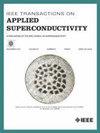Study on the Vibration Characteristics of Suspension Frame System for Maglev Train Under Track Irregularity Harmonic Excitation
IF 1.7
3区 物理与天体物理
Q3 ENGINEERING, ELECTRICAL & ELECTRONIC
引用次数: 0
Abstract
In order to avoid the abnormal vibration behavior of the high-temperature superconducting (HTS) flux-pinned magnetic levitation (maglev) train at high velocity (reach up to more than 500 km/h) due to the external interference from the suspension frame system, the vibration characteristics of suspension frame system are studied. First, the levitation force between the HTS combination and the permanent magnet guideway (PMG) is measured by way of the quasi-static test platform, and the empirical formula of levitation force is obtained. Then, the nonlinear vibration differential equation of the suspension frame system under the track irregularity harmonic excitation is established. The first approximate solution is obtained based on the multiscale method, which is verified by way of the numerical solution. Finally, the amplitude–frequency response equation of the suspension frame system under the primary resonance is derived; thus, the influence of running velocity, track irregularity wavelength, and amplitude on the steady-state amplitude is studied. An analytical method for determining the feasible domain of track irregularity parameters under different running velocity is proposed based on the safety standard of the maglev train. The effective domain of track irregularity parameters can be obtained. The methodology and results of this article provide a theoretical foundation for constructing PMG of the HTS flux-pinned maglev train.轨道非规则谐波激励下磁悬浮列车悬架系统振动特性研究
为了避免高温超导磁钉磁悬浮列车在高速运行(高达500 km/h以上)时由于悬挂架系统的外部干扰而产生的异常振动行为,对悬挂架系统的振动特性进行了研究。首先,通过准静态测试平台测量了HTS组合与永磁导轨之间的悬浮力,得到了悬浮力的经验公式;然后,建立了轨道非规则谐波激励下悬架系统的非线性振动微分方程。基于多尺度方法得到了第一个近似解,并通过数值解进行了验证。最后,推导了主共振作用下悬架系统的幅频响应方程;因此,研究了运行速度、轨迹不规则波长和幅值对稳态幅值的影响。基于磁悬浮列车安全标准,提出了一种确定不同运行速度下轨道不平顺参数可行域的解析方法。得到航迹不规则参数的有效域。本文的研究方法和结果为构建高通量磁钉磁悬浮列车的PMG提供了理论基础。
本文章由计算机程序翻译,如有差异,请以英文原文为准。
求助全文
约1分钟内获得全文
求助全文
来源期刊

IEEE Transactions on Applied Superconductivity
工程技术-工程:电子与电气
CiteScore
3.50
自引率
33.30%
发文量
650
审稿时长
2.3 months
期刊介绍:
IEEE Transactions on Applied Superconductivity (TAS) contains articles on the applications of superconductivity and other relevant technology. Electronic applications include analog and digital circuits employing thin films and active devices such as Josephson junctions. Large scale applications include magnets for power applications such as motors and generators, for magnetic resonance, for accelerators, and cable applications such as power transmission.
 求助内容:
求助内容: 应助结果提醒方式:
应助结果提醒方式:


